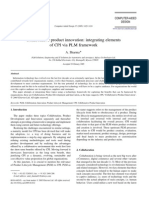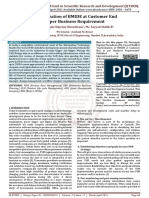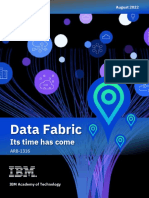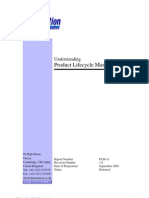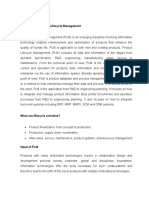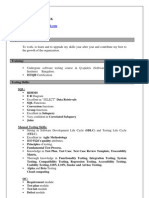From A Monolithic PLM Landscape To A Federated Domain and Data Mesh
From A Monolithic PLM Landscape To A Federated Domain and Data Mesh
Uploaded by
SuelaCopyright:
Available Formats
From A Monolithic PLM Landscape To A Federated Domain and Data Mesh
From A Monolithic PLM Landscape To A Federated Domain and Data Mesh
Uploaded by
SuelaOriginal Title
Copyright
Available Formats
Share this document
Did you find this document useful?
Is this content inappropriate?
Copyright:
Available Formats
From A Monolithic PLM Landscape To A Federated Domain and Data Mesh
From A Monolithic PLM Landscape To A Federated Domain and Data Mesh
Uploaded by
SuelaCopyright:
Available Formats
INTERNATIONAL DESIGN CONFERENCE – DESIGN 2022
https://doi.org/10.1017/pds.2022.73
From a Monolithic PLM Landscape to a Federated Domain and
Data Mesh
Y. Hooshmand 1, , J. Resch 1, P. Wischnewski 2 and P. Patil 3
1 Mercedes-Benz AG, Germany, 2 PROSTEP AG, Germany, 3 HCL Technologies Germany GmbH, Germany
yousef.hooshmand@mercedes-benz.com
Abstract
Product Lifecycle Management (PLM) is one of the most business-critical IT backbones of manufacturing
companies. It often consists of numerous, rigidly interwoven monolithic applications and is seen as
synonymous with costly maintenance, lack of extensibility, and poor scalability. This paper proposes an
approach for transforming a monolithic PLM landscape into a federated Domain and Data Mesh. This
enhances semantic interoperability and enables data-driven use cases by treating data as first-class citizens.
User-centric PLM domains moreover help to increase productivity in the workplace.
Keywords: product lifecycle management (PLM), semantic modelling, software engineering, data
mesh, domain-driven design
1. Introduction
Managing product data along its lifecycle has always been a challenging task for enterprise IT in
manufacturing companies. Based on ISO/IEC/IEEE 15288 (2015), the generic life cycle of a product
consists of the following stages: Concept, Development, Production, Utilization/ Support, and Retirement.
During these stages, various tools are used to manage the generated product data. For example, in early
phases of the Concept stage, Requirements Management (RM) tools are often used to define, to document
and to manage the requirements. As development continues, various applications such as Product Data
Management (PDM), Application Lifecycle Management (ALM), Enterprise-Resource-Planning (ERP),
and Internet of Things (IoT) Platforms come into play. Each of these applications is used to manage a
subset of product data that is generated during product lifecycle and pertaining to a product context. The
product data is exchanged between these applications realizing business use cases across applications and
across departments. Figure 1 shows the product lifecycle phases as well as the PLM landscape of a
manufacturing company with more than 100 software tools for data handling and numerous interfaces for
data exchange.
The business issues facing manufacturing companies, such as the abrupt electrification of powertrains, the
demand for connected devices, and the handling of (big) data, are emerging at an accelerating pace. This is
leading to challenges in realizing unconventional business requirements using conventional IT Landscape.
To overcome this, on one end companies are trying to align their IT Landscape to new internal and external
requirements. On the other end, independent software vendors are offering platform solutions that promise
a homogeneous IT landscape to be competitive in disruptive situations. However, the platform solutions do
not cover all aspects of changing business requirements. Furthermore, the challenges related to semantic
interoperability, semantic configuration, and data consistency in the IT landscape, as well as data
discoverability and usability, are not properly addressed. These are essential for an organization to be both
data-driven and user-centric in order to thrive in disruptive situations.
DESIGN INFORMATION AND KNOWLEDGE 713
https://doi.org/10.1017/pds.2022.73 Published online by Cambridge University Press
Figure 1. Product lifecycle phases and PLM landscape
The challenges along the product lifecycle can be considered both from a business process perspective and
from a technological perspective. The PLM challenges from the process perspective have been the
dominant topic in the literature. To overcome these challenges, various authors including Eigner (2021),
Dickopf (2020), Pfenning (2017) and Hooshmand et al. (2017, 2018) have proposed sophisticated
approaches that cover either the entire product lifecycle or a specific aspect of it.
The approach proposed by Pfenning et al. (2021), on the other hand, focuses on technological aspects of
PLM space and addresses several problems arising from the monolithic nature of PLM tools. The proposed
solution demands a modern cloud-native Web architecture based on Microservices and Linked Data that
enables companies to introduce Model-Based Systems Engineering (MBSE) on the large scale. Likewise,
this article focuses mainly on the technological aspects and proposes an approach towards a data-driven
and user-centric PLM landscape, enabling companies to tackle various challenges.
1.1. PLM landscape challenges
One of the most critical underlying problems in manufacturing companies is that most information systems
are monolithic legacy systems. Bisbal et al. (1999) define legacy information systems as the backbone of
an organization's information flow and the primary tool for consolidating business information. Legacy
systems are typically mission-critical, expensive to maintain due to lack of adequate documentation and
system understanding, difficult to integrate with other systems, extremely difficult to extend or modify,
costly and time-consuming to troubleshoot, and running often on obsolete hardware (Bisbal et al., 1999;
Bennett, 1995).
Monolithic applications usually consist of monolithic User Interfaces, large Application Servers,
Databases, and Data Models (Newman, 2019). This makes it almost impossible to react flexibly and
quickly to emerging requirements that require changes to PLM processes, methods, or tools. The
applications would become rigid even if one of the aspects is monolith. This also leads to poor and
restricted scalability. Complex applications and a highly interwoven PLM landscape make any change or
customization too expensive or even risky for the company.
A further critical problem is that the ability to access, semantically link, and use the data stored in IT
applications is limited. This is often only possible through various time-consuming and cost-intensive data
processing operations (Alharthi et al., 2017). In addition, interoperability between IT applications is
extremely restricted, which, among other things, makes an End-to-End Configuration Management along
the product lifecycle nearly impossible or very difficult.
714 DESIGN INFORMATION AND KNOWLEDGE
https://doi.org/10.1017/pds.2022.73 Published online by Cambridge University Press
Finally, IT tools do not reflect the company's business capabilities and domains, which hinders the natural
flow of information. The domain data is often scattered in various tools with overlapping functionalities.
As a result, many domain experts work with multiple tools daily to accomplish a single business use case.
Therefore, the current philosophy is: User adapts to Technology. This in turn slows down decision-making
processes and thus the ability to react quickly to arising change requests and new requirements.
To overcome some of the above challenges, various approaches have been evolved to migrate a monolithic
legacy system to solutions with modern architectures such as Microservices Architectures (Taibi et al.,
2017). However, these approaches are not really practiced by most application vendors in the PLM space,
nor are they seriously considered by most manufacturing companies.
There exist several strategic options for migrating a legacy system, namely Conversion, Reimplementation,
Redevelopment, Wrap, and Replace (Sneed and Verhoef, 2019). Due to the strategic importance of the
PLM landscape for manufacturing companies, reimplementation and redevelopment are more promising,
for example, to ensure the long-term goals like flexibility. However, different strategies can be pursued for
different business domains and capabilities. For one PLM domain it may be sufficient to acquire a
commercial software application from the market, for another a completely new development may be
required. It is only important not to compromise the overall strategic goals such as semantic interoperability
or usability.
1.2. Business needs demanding a new PLM landscape
To remain competitive in the current highly dynamic market situation, manufacturing companies must
react quickly to new internal and external requirements. Among other things, this requires companies to
quickly adapt their processes and IT tools along the entire product lifecycle. To achieve this, they must stay
flexible in the face of unforeseen and disruptive requirements that can arise at any time (Highsmith et al.,
2020). Furthermore, they need to be data-driven to gain insights faster and to make quicker decisions based
on the knowledge gained from the internal and external data. This, in turn, requires fast access to and
semantic linking of their data, which is often scattered in various IT tools or data silos throughout the
company.
This paper presents a methodology for designing a PLM landscape that meets the following three
requirements, among others: First, the solution is designed according to the user-centric principle. This
provides users with the right tool with proper usability to perform their tasks in the most efficient way.
Second, the landscape consists of inherently adaptable and extendable solutions, capable of providing new
functionalities on a daily basis. Consequently, the software can be quickly adapted to meet new
requirements that arise from the ever-faster changing markets. Third, data is available in the landscape as a
self-service to users. Following the data-driven principle, this enables effective use of the available data to
quickly obtain information and gain new insights based on data.
The next section briefly presents selected concepts, methodologies and philosophies used intensively in this
work to enable the transition from the current monolithic PLM landscape to the desired federated Domain
and Data Mesh.
2. Tools to tackle PLM landscape challenges
A range of approaches, technologies and methods are required to holistically cope with the challenges
mentioned above. For example, the Semantic Web Technology is used to improve the interoperability of data
along the product lifecycle and to enable much-needed Semantic Configuration Management. In addition, the
Semantic Web is leveraged to enable model-driven software development and to introduce model-driven
software components. This enables efficient and effective extensibility and creates inherent flexibility to meet
new arising requirements. Furthermore, it empowers companies to respond quickly to new internal and
external requirements.
Domain-Driven Design and Data Mesh are used as main architectural design approaches and methodologies
to cut the monolith PLM applications in smaller user-centred pieces or domains. Thus, both operational and
data-centred use cases can be addressed with priority and based on value-driven metrics. The operational use
cases help knowledge workers to work more effectively and efficiently. The data-centred use cases enable the
company to be data- and knowledge-driven. Modern architectural design approaches such as microservices
and micro-frontend are also used to ensure independence and flexibility of components in the landscape.
DESIGN INFORMATION AND KNOWLEDGE 715
https://doi.org/10.1017/pds.2022.73 Published online by Cambridge University Press
2.1. Semantic Web Technology
The Semantic Web aims to represent data and information on the Internet in such a way that machines
are able to independently analyse data and interact with other machines and even humans (Berners-
Lee et al., 2001). This is an attempt to make the Web "intelligent" by using various technologies
forming the Semantic Web Technology Stack (W3C, 2015). As illustrated in the Figure 2, established
Web technologies form the foundation of the Semantic Web. Linked Data is seen as a subset of this
stack. Communication mechanisms such as HTTP, encoding standards such as Unicode, identification
mechanisms such as IRI/URI, and authentication mechanisms are implemented in this foundational
layer. On top of that, representation syntaxes and formats such as TURTLE, JSON-LD, RDFa and
μFormats as well as the RDF (Resource Description Framework) are built. RDF is indeed one of the
key building blocks of the semantic Web, standardizing the description and exchange of data across
the Web. RDF also makes the data searchable via SPARQL (SPARQL Protocol And RDF Query
Language), which is another important building block for both querying and handling data.
The technologies described so far are truly essential for standardized data exchange and data
integration on the Web. However, true semantics can only be realized through the introduction of
modelling languages (such as OWL and RDFS) and rule languages (such as RIF and SHACL). These
languages are crucial for creating sophisticated models of real-world phenomena and systems,
breathing semantic soul into the data, and making it machine interpretable.
Figure 2. Semantic Web Technology Stack (Nowack, 2009)
The core promise of the Semantic Web is achieved by using the aforementioned highly standardized
technologies as we build applications. Top layers of the stack (including Logic and Trust) are not yet
standardized and are mainly still in academic stages.
2.2. Domain-Driven Design
Evans (2003) proposed Domain-Driven Design (DDD) as a software development approach, in which
development is done based on domain models with rich content about the business processes and rules
of the related domain capabilities. This approach is especially helpful in developing software solutions
with large domains and complex logic. To prevent ambiguity in DDD, a Ubiquitous Language or a
common language have to be used to embed the domain terminology into the software systems. It is
important that both software developers and domain experts collaborate and jointly develop the
ubiquitous language of the domain model (Vernon, 2016).
The complexity of large models and teams is handled by dividing them into different Bounded
Contexts (domains) and being explicit about their interrelationships. Each domain can also be divided
716 DESIGN INFORMATION AND KNOWLEDGE
https://doi.org/10.1017/pds.2022.73 Published online by Cambridge University Press
in subdomains. Contexts are defined based on the actual customer use cases of a domain. A context
thus bundles the functionality that is coherent for a particular domain (Vernon, 2016). A microservice
architecture can then be designed based on the contexts and sub-contexts (Newman, 2019). The
interfaces between the services of different contexts should be minimal and simple (Evans, 2003).
This allows each domain to implement and publish its functionalities and services independently. This
is a prerequisite for the daily provision of new functions in the IT landscape. Furthermore, a Context
Map can be used to illustrate the relationships between bounded contexts (domains) and to make the
interfaces and the interconnections among them more transparent.
Various patterns introduced by Evans (2003) and later Vernon (2016) offers useful tools for an
effective strategic (re-)design of complex enterprise applications or even the entire IT landscape.
Leveraging the DDD approach, Newman (2019) also defines a set of patterns for migrating a
monolithic system to a modern microservice architecture.
By concentrating on domains with clear boundaries, the complexity of software coupling will be
significantly reduced. This accelerates the development and increases the release cycle and the
stability of the software components in each domain.
2.3. Data Mesh
The key idea of Data Mesh is to apply DDD and Product Thinking to the challenges in the data and
analytics space. Product Thinking is a product-oriented way of funding and organizing software
development as opposed to software projects (Narayan 2018). Dehghani (2022) proposed Data Mesh as a
new approach, aiming at effective and efficient sourcing, managing, and accessing data for analytical use
cases at scale. To address aforementioned challenges, Data Mesh relies on four principles, namely domain-
oriented decentralized data ownership and architecture, data as a product, self-serve data infrastructure as a
platform, and federated computational governance (Dehghani, 2022).
Based on the first principle, data decomposition takes place according to domains as explained in section
2.2. Consequently, the domain owns the data and the dataset. Thus, operational capabilities and data access
as well as analytical data provided and owned by the domain. This is in contrast to a Data Lake approach,
where one data team is responsible for providing analytical data to all business domains. The Data Mesh
approach enables the companies to be data-driven with end-to-end responsibility for data owners. Based on
this principle the duplication of data is allowed and a domain can have multiple data products. The second
principle aims to serve data as product and ensures that the data products are Discoverable, Self-describing,
Addressable, Trustworthy, Interoperable and Secure. Input Data Ports (IDP) and Output Data Ports (ODP)
are used to receive data from upstream systems and to provide data to downstream systems.
The third principle leverages platform thinking by creating a shared domain-agnostic self-service data
infrastructure to lower the cost and specialization needed to build data products. It helps to create secure
data products quickly and execute their pipelines. Furthermore, it focuses on supporting and enabling the
collaboration between data producers and data consumers. The last principle ensures domain self-
sovereignty as well as interoperability through global standards. It can cope with a dynamic topology by
automatic execution of decisions and by computational validation. Standardization of semantics and syntax
as well as global rules are major enablers for this principle. The global interoperability standards ensure that
the mesh behaves as a consistent interoperable ecosystem.
3. Domain-driven PLM landscape
A domain-oriented redesign and development of the PLM landscape is essential to overcome the
challenges discussed in the previous sections. This facilitates especially the consolidation of data and
functionalities scattered across various systems. Therefore, the new philosophy will be: Technology adapts
to User. It also addresses the goals of fast deployment and making data available for self-service analytics.
In this section, the proposed domain-driven PLM landscape in which the DDD and Data Mesh principles
are embedded is first schematically presented at a high level. A sample domain is then used to describe
various aspects and the domain structure in more detail. The approaches and technologies presented in
section 2 are combined and slightly adapted to meet the requirements of the desired PLM landscape. The
data products are always considered as part of a bounded context forming a (sub)domain and RDF, OWL
and SHACL are used extensively to describe every aspect of domains.
DESIGN INFORMATION AND KNOWLEDGE 717
https://doi.org/10.1017/pds.2022.73 Published online by Cambridge University Press
3.1. Domain's context map
The context of this article is limited to the business domains in design, manufacturing and after sales
phases, which comprise the classic PLM core functionalities of manufacturing companies. However,
the presented approach is extensible to the entire lifecycle of the product. Depending on how we
define the bounded contexts and delineate the domains, about 12 to 16 domains will be required to
replace the systems currently used in the above phases. Figure 3 shows schematically selected PLM
domains and their interactions.
Each domain has its own data model, its own data storage and infrastructure. As it contains all the
data that is needed to be fully functional, the domain is independently operational. For example,
the part domain has about 50 classes with a few hundred attributes. The BOM domain needs few
classes and attributes from the part domain to be independently operational. This data is provided
asynchronously and near-real-time via event streaming platforms like Kafka. Thus, the BOM
domain remains functional even if the part domain is temporarily unavailable. Each business object
can be created or modified only in one domain, but its data can reside in various consecutive
domains. The business objects can also be extended with further data in subsequent domains (e.g.,
by adding new attributes to the object model) but their changes will not be synchronized back to
the source domain. The definition of Single Source of Truth is thus altered to Nearest Source of
Truth based on Single Source of Change.
Figure 3. Schematic context map of selected PLM domains
Although the domain models can be changed locally and independently in each domain or bounded
context, global governance ensures consistency and interoperability across domains. This is discussed
in more detail in following sections.
The legacy systems remain part of the PLM landscape as long as the functionalities have not been
fully migrated or the data supply has not been switched over. The migration takes place in smaller
steps so that the provision of the process chain remains guaranteed. It is also worth noting that
domains can be built on proprietary components, open-source components, in-house developments, or
a combination of these. The only important thing is that they are not built as monolithic, rigid
solutions and that interoperability is ensured.
Using part domain as an example, the next section will dive deeper and show how a domain is
constructed and what technologies are used.
718 DESIGN INFORMATION AND KNOWLEDGE
https://doi.org/10.1017/pds.2022.73 Published online by Cambridge University Press
3.2. Domain structure and setup
In accordance with the domain-driven design and data mesh approaches, each domain has its own
domain model and one or more data products with their own data storages. In addition,
communication with the domains takes place via ports. The operational ports are marked with O and
are required for data processing based on a business logic. As can be seen in Figure 4, services such as
Create Part or Create CAD can be accessed only through corresponding operational ports. The data
ports, on the other hand, are marked with D and are responsible for data import through IDP and data
export through ODP. Both operational ports and data ports are subject to version control and global
governance to ensure interoperability between the domains.
Although most domains initially have only one data product with one database, new data products can
be added as the domain grows or business, technical, or legal requirements necessitate. As shown
schematically in Figure 4, a second data product with a higher SLA (Service Level Agreements) is
used for parts that are released for manufacturing. This data product can also be enriched with
additional manufacturing-specific information through further operational ports. The same
technologies are used for intra-domain data exchange as for cross-domain data exchange.
Furthermore, local intra-domain governance ensures the interoperability between data products.
Figure 4. Internal structure of a domain
The modelling languages OWL and SHACL (W3C, 2015) are used to create a semantically precise
domain model. Although the domain models are small, with an average of 40 classes, the domain models
are moreover built in a modular format to cover different aspects in independent small modules. For
example, the information needed for data validation is stored in a separate module to reduce memory
requirements in corresponding services and make the collaborative maintenance of the domain model
more efficient. The modules comprise the data model, various aspects of the business logic, and the
domain interfaces. The domain model is thus the sum of all modules that are semantically linked and
form a unit.
3.3. Model-driven software components and services
The software components are mainly designed according to a software development approach in
which the behaviour of each software component is generically controlled by the domain model. For
example, data validation is performed in different domains by using the same software library but
different domain-specific models to produce different behaviours. This drastically increases efficiency
DESIGN INFORMATION AND KNOWLEDGE 719
https://doi.org/10.1017/pds.2022.73 Published online by Cambridge University Press
in the development, maintenance, and reuse of software components needed in multiple domains.
Furthermore, new requirements can often be met only by extending or modifying the domain model
without having to change the software code at all.
The domain model acts as an interface between domain experts and software developers to define the
desired domain behaviour. Thus, new requirements and ideas can first be discussed based on semantic
models to define the intended behaviour. The first software prototypes can often be developed in hours
and days instead of weeks and months.
A consolidated user interface approach across all domains and services helps to provide a seamless
experience for users. Although numerous independent services and software solutions are offered in
different domains, a unified role-based user interface is provided to support users in their daily tasks.
In most cases, users don't even realize which domain they are interacting with. At the same time, by
using different approaches such as Micro Frontends or Backends For Frontends, each segment of the
user interface can be developed and deployed almost 100% independently. Thus, domains retain
sovereignty over the release cycle of their software components from backend to user interface.
3.4. Cross-domain Semantic Layer
As explained in section 3.2 the domain models are built modular to cover different aspects in different
modules. The modules describing the data models and the domain interfaces (IDPs and ODPs) are
particularly important both to ensure interoperability across domains and to enable self-service data access.
A cross-domain Integration model semantically connects the models originating from different domains.
The Integration model also connects the domain models with an Enterprise upper ontology as well as a
company-specific Terminology model and forms a Semantic Layer and thus enables, among other things,
cross-domain semantic interoperability and analytical use cases. The Integration model is modular and
covers various aspects of integration in different modules.
The semantic relationships among domains and their data are explicitly part of the Integration model and
not hidden in any piece of business logic code. Since both the domain models and the Integration model are
developed based on the same modelling language described in section 2.1, their integration as well as their
subsequent exploitation is seamless. This makes the domain data much easier discoverable both by data
analysts and by machines. Capabilities for accessing and exploring the models as well as the domain data
are provided by the PLM infrastructure, described in section 4, through lookup services and distributed
query engines. The infrastructure provides the necessary tools for creating actual data-driven applications.
To enable holistic data-driven solutions, a Semantic Layer consisting of the following semantically
integrated aspects is thus required.
The Enterprise upper ontology is a domain-agnostic ontology model covering the main
concepts and business objects of the company. All domain-specific business objects can be
derived directly or indirectly from the objects in this model. An Enterprise upper ontology
emerges gradually over time as domains evolve. It generally is composed of a few hundred
unambiguous classes and properties.
The Domain models semantically describe the domains in the PLM landscape. Each domain
model comprises different domain facets, including the data model, different aspects of the
business logic and the domain interfaces in several modules.
The Terminology model combines generic and company-specific terms in a semantically
unambiguous model. This model is particularly important for data-driven use cases that
combine structured and unstructured data.
The Integration model semantically integrates and connects the previous models, forming a
coherent Semantic layer.
The Semantic Layer is a prerequisite for transforming the fragmented PLM data silos into a live
enterprise knowledge graph.
4. Infrastructure for Domain-driven PLM landscape
Compared to a monolithic landscape, the number of software components in a domain-driven
landscape multiplies. Therefore, a unified, cross-domain PLM platform is a prerequisite for the
720 DESIGN INFORMATION AND KNOWLEDGE
https://doi.org/10.1017/pds.2022.73 Published online by Cambridge University Press
efficient implementation and operation of the desired PLM landscape. This is also a prerequisite for a
unified, consistent, and interoperable ecosystem. The generic platform follows the Data Mesh
(Dehghani, 2022) approach, which treats data as a first-class citizen in all affairs. The PLM platform
encompasses both a domain-agnostic infrastructure and a federated governance of the PLM landscape.
4.1. Domain-agnostic infrastructure
The infrastructure provides generic, domain-agnostic capabilities to efficiently build and maintain the
PLM landscape. Using a generic infrastructure to build domains also helps to reduce costs and requires
less specialization. Among other things, infrastructure capabilities include distributed file storage
provisioning, access control, identity management, monitoring, orchestration mechanisms, and API
versioning. Although most cloud providers such as Microsoft Azure or Amazon AWS offer similar
capabilities, these still need to be customized and adapted to the needs of the PLM landscape. An
Infrastructure-as-a-Service (IaaS) strategy therefore better meets the long-term requirements of the PLM
landscape.
In addition to the core capabilities required to operate and maintain each PLM domain and the overall
landscape, the PLM infrastructure offers cross-domain functionalities such as distributed query
engines or data catalogues. These are especially needed for data scientists and data analysts to
facilitate the transition to a data- and knowledge-driven enterprise. In addition, the infrastructure
supports and facilitates collaboration between different domains.
4.2. Federated governance
A consistent interoperable landscape requires a governance model that embraces decentralization and
domain self-sovereignty as well as interoperability through global standardization. Global standards
include schema syntax, data formats, modelling languages, metadata formats and syntax, generic
objects, dataset schema, and requirements regarding security and compliance. In addition, global API
versioning policies as well as data port release rules are important parts of the governance model for
ensuring global interoperability of the landscape. The cross-domain Integration Model described in
section 3.4 is also maintained as part of global governance. The local rules and standards, on the other
hand, guarantee the decentralization and autonomy of the domains.
A federated computational governance is a prerequisite for efficient maintenance of the dynamic
topology of the landscape through automatic execution of decisions. It includes both local intra-
domain decisions and global decisions.
5. Summary
In this article, a new PLM landscape in the form of a federated Domain and Data Mesh is proposed. By
leveraging modern approaches such as Domain-Driven Design and Data Mesh, as well as technologies
such as Semantic Web, the proposed Domain-driven PLM landscape tackles various technical, operational
and business challenges faced by manufacturing companies. It also meets new requirements essential to
make an enterprise data- and knowledge-driven. In addition, the new landscape is inherently user-centric in
design, helping to make enterprise IT more focused on users and their real needs for their daily tasks. The
model-driven software components and services help to significantly increase the synergy between the
domains and improve efficiency in the development, maintenance and reuse of the software components.
By shifting from traditional Single Source of Truth philosophy to Nearest Source of Truth based on Single
Source of Change philosophy, the monolithic legacy PLM solutions are efficiently replaced with modern
user-centric domains in a federated landscape. This enables enterprises to respond quickly and flexibly to
new requirements. A cross-domain Semantic Layer ensures cross-domain semantic interoperability and
enables holistic data-driven solutions and analytical use cases transforming the fragmented PLM landscape
into a living knowledge graph.
Finally, a domain-agnostic PLM infrastructure leverages platform thinking across all domains and ensures
global interoperability through global standards as well as domain self-sovereignty through local standards.
DESIGN INFORMATION AND KNOWLEDGE 721
https://doi.org/10.1017/pds.2022.73 Published online by Cambridge University Press
Disclaimer: The content of this article originates from a still ongoing project at Mercedes-Benz AG,
therefore the final result may differ slightly. In addition, any comment towards vendors or third parties is
authors’ own opinions.
References
Alharthi, A.; Krotov, V.; Bowman, M. (2017), Addressing barriers to big data, Business Horizons, Volume 60,
Issue 3, Pages 285-292. https://doi.org/10.1016/j.bushor.2017.01.002
Bennett, K. (1995), Legacy systems: coping with success, IEEE Software, vol. 12, no. 1, pp. 19-23. doi:
10.1109/52.363157
Berners-Lee, T.; Hendler, J.; Lassila, O. (2001), The Semantic Web, Scientific American, vol. 284, no. 5, pp.34-
43. https://www.jstor.org/stable/26059207
Bisbal, J.; Lawless, D.; Wu, B.; Grimson, J. (1999), Legacy information systems: issues and directions, IEEE
Software, vol. 16, no. 5, pp. 103-111. doi: 10.1109/52.795108
Dehghani, Zh. (2022), Data Mesh: Delivering Data-Driven Value at Scale (1.ed - preview version), O’Reilly
Media, Inc.
Dickopf, Th. (2020), A holistic methodology for the development of cybertronic systems in the context of the
Internet of Things, [PhD Thesis], Kaiserslautern. https://doi.org/10.2370/9783844073690
Eigner, M. (2021), System Lifecycle Management - Digitalisierung des Engineering, Springer Vieweg, Berlin.
https://doi.org/10.1007/978-3-662-62183-7
Evans, E. (2003), Domain-Driven Design: Tackling Complexity in the Heart of Software, Boston, Addison-
Wesley Professional.
Highsmith, J.; Luu, L.; Robinson, D. (2020), EDGE: Value-Driven Digital Transformation, Boston, Addison-
Wesley.
Hooshmand, Y.; Adamenko, D.; Kunnen, S.; Köhler, P. (2017), An approach for holistic model-based
engineering of industrial plants, 21st International Conference on Engineering Design (ICED17),
Vancouver.
Hooshmand, Y.; Adamenko, D.; Kunnen, S.; Köhler, P. (2018), Semi-Automatic Creation of System Models
based on SysML Model Libraries, INCOSE EMEA Sector Systems Engineering Conference, Berlin.
ISO/IEC/IEEE (2015), ISO/IEC/IEEE 15288:2015: Systems and Software Engineering - System Life Cycle
Processes, International Organisation for Standardization, Geneva.
Narayan, S. (2018), Products Over Projects, [online]. Available at: https://martinfowler.com/articles/products-over-
projects.html (accessed 05.11.2021).
Newman, S. (2019), Monolith to Microservices: Evolutionary Patterns to Transform Your Monolith, O'Reilly
Media, Inc.
Nowack, B. (2009), The Semantic Web – Not a Piece of cake…, [online]. Available at:
http://bnode.org/blog/2009/07/08/the-semantic-Web-not-a-piece-of-cake (accessed 18.07.2021).
Pfenning, M.; Reichwein, A.; Hooshmand, Y.; Dickopf, T.; Bleisinger, O.; Psota, T.; Masior, J.; Roth, A.;
Muggeo, C.; Hutsch, M. (2021), Killing the PLM Monolith – the Emergence of cloud-native System
Lifecycle Management (SysLM), Fraunhofer-Publica Verlag.
Pfenning, M. (2017), Durchgängiges Engineering durch die Integration von PLM und MBSE, [PhD Thesis],
Technical University Kaiserslautern.
Sneed, H.; Verhoef, Ch. (2019), Re-implementing a legacy system, Journal of Systems and Software, Volume
155, Pages 162-184. https://doi.org/10.1016/j.jss.2019.05.012
Taibi, D.; Lenarduzzi, V.; Pahl, C. (2017), Processes, Motivations, and Issues for Migrating to Microservices
Architectures: An Empirical Investigation, IEEE Cloud Computing, vol. 4, no. 5, pp. 22-32. doi:
10.1109/MCC.2017.4250931
Vernon, V. (2016), Domain-Driven Design Distilled, Boston, Addison-Wesley Professional.
W3C (2015), Semantic Web - Leading the web to its full potential, [online]. Available at:
https://www.w3.org/standards/semanticweb (accessed 18.07.2021).
722 DESIGN INFORMATION AND KNOWLEDGE
https://doi.org/10.1017/pds.2022.73 Published online by Cambridge University Press
You might also like
- Building Office Add-Ins Using OfficejsDocument261 pagesBuilding Office Add-Ins Using OfficejsVineeth BabuNo ratings yet
- How To InstallDocument4 pagesHow To InstallkikiNo ratings yet
- Techniques in EPC ProjectsDocument11 pagesTechniques in EPC ProjectsSantiago PENo ratings yet
- Bluestar PDM/PLM For Microsoft Dynamics Ax: A Cimdata Program ReviewDocument23 pagesBluestar PDM/PLM For Microsoft Dynamics Ax: A Cimdata Program Reviewliviu_stoica55742No ratings yet
- Fanuc 10t Maintenance Manual: Read/DownloadDocument2 pagesFanuc 10t Maintenance Manual: Read/DownloadPradeep Patel25% (4)
- User Manual - IIDR CHCCLP Scripting 1 © 2015 IBM CorporationDocument24 pagesUser Manual - IIDR CHCCLP Scripting 1 © 2015 IBM CorporationJulio Cesar Rivero OblitasNo ratings yet
- Components of Product Lifecycle Management and Their ApplicationDocument6 pagesComponents of Product Lifecycle Management and Their Applicationmayurkh73No ratings yet
- Product Lifecycle Management For Cross-X Engineering DesignDocument12 pagesProduct Lifecycle Management For Cross-X Engineering DesignAnonymous St1j35DR05No ratings yet
- Collaborative Product Innovation - Integrating Elements of CPI Via PLM FrameworkDocument10 pagesCollaborative Product Innovation - Integrating Elements of CPI Via PLM FrameworkkhukiiNo ratings yet
- Cloud ComputingDocument4 pagesCloud ComputingOmair NisarNo ratings yet
- Challenges of Production MicroservicesDocument6 pagesChallenges of Production Microservicessleyter94No ratings yet
- DETC2004-57745: Manufacturing Information Integration in Product Lifecycle Management (PLM)Document7 pagesDETC2004-57745: Manufacturing Information Integration in Product Lifecycle Management (PLM)AVI_ROHININo ratings yet
- Cad Pub 2005Document14 pagesCad Pub 2005Carlos FranchNo ratings yet
- Artificial Intelligence in Product Lifecycle ManagementDocument26 pagesArtificial Intelligence in Product Lifecycle Managementgaganpreets.bungaiNo ratings yet
- How Do I Coordinate DesignDocument8 pagesHow Do I Coordinate DesignjvwzyxktuvnjohdkbjNo ratings yet
- Cloufa SDF Sadf Asfa e htsasWRG WRDocument43 pagesCloufa SDF Sadf Asfa e htsasWRG WRShaneNo ratings yet
- BW Pickling+Handbook EN 2019 GL 128 PreviewDocument10 pagesBW Pickling+Handbook EN 2019 GL 128 PreviewAsgard SanchezNo ratings yet
- Capturing Value From IT Infrastructure InnovationDocument10 pagesCapturing Value From IT Infrastructure InnovationhanporrasNo ratings yet
- Mis at DellDocument15 pagesMis at DellJomin PjoseNo ratings yet
- Business Innovation: Lorem Ipsum Dolor Sit Amet, Consectetuer Adipiscing ElitDocument5 pagesBusiness Innovation: Lorem Ipsum Dolor Sit Amet, Consectetuer Adipiscing Elitanupkp2007No ratings yet
- Big Data in Product Lifecycle ManagementDocument18 pagesBig Data in Product Lifecycle Management吴善统No ratings yet
- Technical Essay: Legacy Software Support Tatiana YaldaieDocument7 pagesTechnical Essay: Legacy Software Support Tatiana YaldaieTatiana YaNo ratings yet
- PDF Managing and Using Information Systems A Strategic Approach 6th Edition Pearlson Solutions Manual downloadDocument49 pagesPDF Managing and Using Information Systems A Strategic Approach 6th Edition Pearlson Solutions Manual downloadvianisisacio100% (8)
- Accenture The Cloud Imperative Software Platforms IndustryDocument15 pagesAccenture The Cloud Imperative Software Platforms Industry126Monish BNo ratings yet
- Customization of BMIDE at Customer End As Per Business RequirementDocument6 pagesCustomization of BMIDE at Customer End As Per Business RequirementEditor IJTSRDNo ratings yet
- 1 s2.0 S2212827117312039 Main PDFDocument6 pages1 s2.0 S2212827117312039 Main PDFjoel zapanaNo ratings yet
- Business Continuity Plan and Disaster RecoveryDocument5 pagesBusiness Continuity Plan and Disaster RecoveryBrian MaingiNo ratings yet
- Challenges of Digital Twin in High Value Manufacturing - (Singh2018)Document10 pagesChallenges of Digital Twin in High Value Manufacturing - (Singh2018)Ashish MalikNo ratings yet
- BSC (Hons) Business Management Cohort 2 Bmp4005 Information Systems and Big Data AnalysisDocument10 pagesBSC (Hons) Business Management Cohort 2 Bmp4005 Information Systems and Big Data Analysisriyatt0111No ratings yet
- Development Methods and Frameworks: Future of Systems Development MethodologiesDocument27 pagesDevelopment Methods and Frameworks: Future of Systems Development MethodologiesYvonNo ratings yet
- Enterprise Data Management TypesDocument66 pagesEnterprise Data Management TypesAkinola SamuelNo ratings yet
- White Paper - Enterprise Content ManagementDocument24 pagesWhite Paper - Enterprise Content ManagementRui MartinsNo ratings yet
- ARB 1316 - Whitepaper - DataFabric - Its Time Has ComeDocument35 pagesARB 1316 - Whitepaper - DataFabric - Its Time Has ComeMaria PilarNo ratings yet
- Building Scalable Business AutomationDocument11 pagesBuilding Scalable Business AutomationJUAN BARRAGANNo ratings yet
- A Product Information Modeling Framework For Product Lifecycle ManagementDocument18 pagesA Product Information Modeling Framework For Product Lifecycle ManagementHarsh ShahNo ratings yet
- Chapter 6: Architecture and InfrastructureDocument12 pagesChapter 6: Architecture and InfrastructureAhmed MohamadNo ratings yet
- Download Study Resources for Managing and Using Information Systems A Strategic Approach 6th Edition Pearlson Solutions ManualDocument48 pagesDownload Study Resources for Managing and Using Information Systems A Strategic Approach 6th Edition Pearlson Solutions Manualisaisfijalv4100% (7)
- Software Solutions-Article ReprintDocument4 pagesSoftware Solutions-Article ReprintRavi ShankarNo ratings yet
- Management Information System at DellDocument15 pagesManagement Information System at DellNeha ParabNo ratings yet
- Managing-App - And-Data-In-The-Digitally-Transformed-Business - 9pgDocument9 pagesManaging-App - And-Data-In-The-Digitally-Transformed-Business - 9pgNewReaderNo ratings yet
- Smarter IT: Optimize IT Delivery, Accelerate Innovation: InsideDocument15 pagesSmarter IT: Optimize IT Delivery, Accelerate Innovation: InsidedachronicmasterNo ratings yet
- Analysys Mason Future of Big Data Jul2014Document14 pagesAnalysys Mason Future of Big Data Jul2014kris_neel100% (1)
- PLM Application Acceleration: Optimize Performance in Distributed R&D EnvironmentsDocument6 pagesPLM Application Acceleration: Optimize Performance in Distributed R&D EnvironmentsMTNo ratings yet
- Product Lifecycle Management: UnderstandingDocument20 pagesProduct Lifecycle Management: Understandinganurag_kapila3901No ratings yet
- Data Visualization For Industry 4Document3 pagesData Visualization For Industry 4aryNo ratings yet
- Management Information System ofDocument22 pagesManagement Information System ofJasMeetEdenNo ratings yet
- LCI Ebook DS PDM v15 PDFDocument8 pagesLCI Ebook DS PDM v15 PDFVrukshwalli KateNo ratings yet
- Ecosystem White PaperDocument24 pagesEcosystem White Paperrainworm99No ratings yet
- A Guideline For The Requirements Engineering Process of SMEs Regarding To The Development of CPSDocument10 pagesA Guideline For The Requirements Engineering Process of SMEs Regarding To The Development of CPSAlia KhalidNo ratings yet
- PLMDocument10 pagesPLMUmesh GoleNo ratings yet
- Software Tools For Conducting Real-Time Information Processing and Visualization in IndustryDocument20 pagesSoftware Tools For Conducting Real-Time Information Processing and Visualization in IndustryAhamed ZahvieNo ratings yet
- IBM Product DevelopmentDocument12 pagesIBM Product DevelopmentBelencita ParragaNo ratings yet
- CH-5 pdfDocument10 pagesCH-5 pdfYimenu GedamNo ratings yet
- Mills-Brand1997 Chapter TheSystemIntegrationArchitectu PDFDocument14 pagesMills-Brand1997 Chapter TheSystemIntegrationArchitectu PDFCarlville Jae EdañoNo ratings yet
- Overview of Product Lifecycle ManagementDocument20 pagesOverview of Product Lifecycle ManagementNalini Sharma100% (1)
- Big Data Management and Cloud ComputingDocument7 pagesBig Data Management and Cloud Computingserkalem yimerNo ratings yet
- Product Lifecycle Management in Aviation Maintenance, Repair and OverhaulDocument8 pagesProduct Lifecycle Management in Aviation Maintenance, Repair and OverhaulamirmahdaviNo ratings yet
- Managerial Economics Assignment Jantodec16 AmityDocument20 pagesManagerial Economics Assignment Jantodec16 AmityAkhilesh100% (3)
- Western Digital Transformation StoryDocument10 pagesWestern Digital Transformation Storymba23201No ratings yet
- Architecture and Framework For Machine Learning As A ServiceDocument8 pagesArchitecture and Framework For Machine Learning As A ServiceDuc ThuyNo ratings yet
- 1 s2.0 S221282712300954X MainDocument6 pages1 s2.0 S221282712300954X Mainayikhalakbar1717No ratings yet
- Product Lifecycle ManagementDocument14 pagesProduct Lifecycle ManagementArunachalam MuthiahNo ratings yet
- Enterprise Architecture with .NET: Expert-backed advice for information system design, down to .NET and C# implementationFrom EverandEnterprise Architecture with .NET: Expert-backed advice for information system design, down to .NET and C# implementationNo ratings yet
- Challenges and Opportunities of 5G Deployment in Ecuador - Extended VersionDocument13 pagesChallenges and Opportunities of 5G Deployment in Ecuador - Extended VersionSuelaNo ratings yet
- SSRN Id2340905Document28 pagesSSRN Id2340905SuelaNo ratings yet
- Faults in Smart Grid Systems: Monitoring, Detection and ClassificationDocument49 pagesFaults in Smart Grid Systems: Monitoring, Detection and ClassificationSuelaNo ratings yet
- 04 SahooDocument24 pages04 SahooSuelaNo ratings yet
- Complete Library Management System Project ReportDocument79 pagesComplete Library Management System Project ReportManoj instituteNo ratings yet
- 3-2 Storage Data Protection Technologies and ApplicationsDocument53 pages3-2 Storage Data Protection Technologies and ApplicationsAlberto ChristyanNo ratings yet
- ASDA-B2-Modo VelocidadeDocument8 pagesASDA-B2-Modo VelocidadeFrancisco RodriguesNo ratings yet
- QAEngineer SQL, Manual Testing, Unix, QC, QTP, VB ScriptingDocument3 pagesQAEngineer SQL, Manual Testing, Unix, QC, QTP, VB ScriptingParinita Singh100% (2)
- Unit 4Document48 pagesUnit 4Kuldeep SinghNo ratings yet
- Assignment 04Document11 pagesAssignment 04Muhammad Saqib0% (1)
- CS151 Exam3 Part2Document3 pagesCS151 Exam3 Part2Zhansaya ZhassulanovaNo ratings yet
- Python Interview Questions With AnswersDocument32 pagesPython Interview Questions With AnswersKrishnqNo ratings yet
- Revised BCA ATKT Exam Time Table 2023-24 (Second)Document1 pageRevised BCA ATKT Exam Time Table 2023-24 (Second)AvieNo ratings yet
- Black Book (7858)Document95 pagesBlack Book (7858)PremNo ratings yet
- Camera Skan RayDocument288 pagesCamera Skan Rayابو حميد ابو حميدNo ratings yet
- SyslogDocument4 pagesSyslogBasma SalahNo ratings yet
- Akshay Pratap - Informatica IICSDocument3 pagesAkshay Pratap - Informatica IICSAkshay ChauhanNo ratings yet
- Computer Networking Multiple Choice Questions & Answers - 1Document8 pagesComputer Networking Multiple Choice Questions & Answers - 1raghad mejeed100% (1)
- ABAP Interview QuestionsDocument49 pagesABAP Interview QuestionsBharat VamsiNo ratings yet
- Device Libraries: Integrated Web SearchDocument23 pagesDevice Libraries: Integrated Web Searchluis GUSTAVONo ratings yet
- Chapter I Review of Basics of Digital ElectronicsDocument21 pagesChapter I Review of Basics of Digital ElectronicsMia LateNo ratings yet
- BP 20C25 20C25 Brochure 3Document8 pagesBP 20C25 20C25 Brochure 3jay yadavNo ratings yet
- Cryptocurrency (And Blockchain) PlaybookDocument17 pagesCryptocurrency (And Blockchain) PlaybookAkshit SinghNo ratings yet
- Recursion: - Recursion Is A Fundamental ProgrammingDocument23 pagesRecursion: - Recursion Is A Fundamental ProgrammingEthan HuntNo ratings yet
- Inmetro Software Requirements-586-12Document13 pagesInmetro Software Requirements-586-12Eliton JuniorNo ratings yet
- Karthika Devi MDocument2 pagesKarthika Devi Maaru6guruNo ratings yet
- Design of Stepper Motor Position Control System Based On DSP, Hua Wei LiDocument5 pagesDesign of Stepper Motor Position Control System Based On DSP, Hua Wei LiMohamad YusufNo ratings yet
- Transportation and Assignment ProblemDocument67 pagesTransportation and Assignment ProblemhanaNo ratings yet
- Design of Single Precision Floating Point Arithmetic Logic UnitDocument5 pagesDesign of Single Precision Floating Point Arithmetic Logic UnitAzhar Yaseen N JNo ratings yet
- AwsarchimtDocument8 pagesAwsarchimtazzuNo ratings yet








